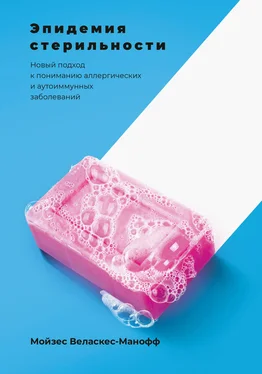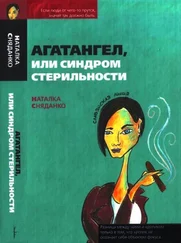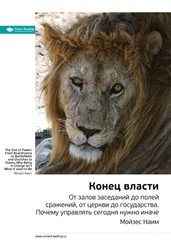U. Gehring et al. “Exposure to Endotoxin Decreases the Risk of Atopic Eczema in Infancy: A Cohort Study”. Journal of Allergy and Clinical Immunology 108, № 5 (2001).
Roger P. Lauener et al. “Expression of CD14 and Toll-like Receptor 2 in Farmers’ and Non-Farmers’ Children”. Lancet 360, № 9331 (2002).
Charlotte Braun-Fahrländer et al., “Environmental Exposure to Endotoxin and Its Relation to Asthma in School-Age Children,” New England Journal of Medicine 347, no. 12 (2002).
Matthew S. Perzanowski et al. “Endotoxin in Inner-City Homes: Associations with Wheeze and Eczema in Early Childhood”. Journal of Allergy and Clinical Immunology 117, № 5 (2006).
Benjamin J. Song, Andrew H. Liu. “Metropolitan Endotoxin Exposure, Allergy and Asthma”. Current Opinion in Allergy and Clinical Immunology 3, № 5 (2003); J. E. Gereda et al. “Metropolitan Home Living Conditions Associated with Indoor Endotoxin Levels”. Journal of Allergy and Clinical Immunology 107, № 5 (2001).
M. K. Tulic, P. G. Holt, P. D. Sly. “Modification of Acute and Late-phase Allergic Responses to Ovalbumin with Lipopolysaccharide”. International Archives of Allergy Immunology 129, № 2 (2002).
Steve M. Lee et al. “Regulatory T-Cells Contribute to Allergen Tolerance Induced by Daily Airway Immunostimulant Exposures”. American Journal of Respiratory Cell and Molecular Biology 44, № 3 (2011).
Meri K. Tulic et al. “Role of Toll-like Receptor 4 in Protection by Bacterial Lipopolysaccharide in the Nasal Mucosa of Atopic Children but Not Adults”. Lancet 363, № 9422 (2004).
O. L. Frick et al. “Allergen Immunotherapy with Heat-Killed Listeria monocytogenes Alleviates Peanut and Food-induced Anaphylaxis in Dogs”. Allergy 60, № 2 (2005).
F. Estelle Simons et al. “Selective Immune Redirection in Humans with Ragweed Allergy by Injecting Amb a 1 Linked to Immunostimulatory DNA”. Journal of Allergy and Clinical Immunology 113, № 6 (2004).
Peter S. Creticos et al. “Immunotherapy with a Ragweed-toll-like Receptor 9 Agonist Vaccine for Allergic Rhinitis”. New England Journal of Medicine 355, № 14 (2006).
Gail M. Gauvreau et al. “Immunostimulatory Sequences Regulate Interferon-Inducible Genes but Not Allergic Airway Responses”. American Journal of Respiratory and Critical Care Medicine 174, № 1 (2006).
T. Shirakawa et al. “The Inverse Association between Tuberculin Responses and Atopic Disorder”. Science 275, № 5296 (1997); T. Annus et al. “Atopic Disorders among Estonian Schoolchildren in Relation to Tuberculin Reactivity and the Age at BCG Vaccination”. Allergy 59; 10 (2004); C. C. Obihara et al. “Inverse Association between Mycobacterium tuberculosis Infection and Atopic Rhinitis in Children”. Allergy 60, № 9 (2005); Graham A. W. Rook, Eckard Hamelmann, L. Rosa Brunet. “Mycobacteria and Allergies”. Immunobiology 212, № 6 (2007).
S. L. Young et al. “Environmental Strains of Mycobacterium avium Interfere with Immune Responses Associated with Mycobacterium bovis BCG Vaccination”. Infection and Immunity 75, № 6 (2007).
Джессика Снайдер Сакс. Микробы хорошие и плохие. Наше здоровье и выживание в мире бактерий. М.: АСТ, 2015.
P. D. Arkwright, T. J. David. “Effect of Mycobacterium vaccae on Atopic Dermatitis in Children of Different Ages”. British Journal of Dermatology 149, № 5 (2003).
Claudia Zuany-Amorim et al. “Suppression of Airway Eosinophilia by Killed Mycobacterium vaccae-induced Allergen-Specific Regulatory T-cells”. Nature Medicine 8, № 6 (2002); J. R. F. Hunt et al. “Intragastric Administration of Mycobacterium vaccae Inhibits Severe Pulmonary Allergic Inflammation in a Mouse Model”. Clinical and Experimental Allergy 35, № 5 (2005).
Информацию об исследованиях, в ходе которых были подтверждены защитные свойства неочищенной воды, см.: Carsten Flohr et al. “Poor Sanitation and Helminth Infection Protect against Skin Sensitization in Vietnamese Children: A Cross-sectional Study”. Journal of Allergy and Clinical Immunology 118, № 6 (2006).
T. Laatikainen et al. “Allergy Gap between Finnish and Russian Karelia on Increase”. Allergy 66, № 7 (2011); Anita Kondrashova et al. “A Six-fold Gradient in the Incidence of Type 1 Diabetes at the Eastern Border of Finland”. Annals of Medicine 37, № 1 (2005); Anita Kondrashova et al. “Lower Economic Status and Inferior Hygienic Environment May Protect Against Celiac Disease”. Annals of Medicine 40, № 3 (2008).
Hanna Viskari et al. “Circulating Vitamin D Concentrations in Two Neighboring Populations with Markedly Different Incidence of Type 1 Diabetes”. Diabetes Care 29, № 6 (2006).
Erkki Vartiainen et al. “Allergic Diseases, Skin Prick Test Responses, and IgE Levels in North Karelia, Finland, and the Republic of Karelia, Russia”. Journal of Allergy and Clinical Immunology 109, № 4 (2002).
Leena C. von Hertzen et al. “Infectious Burden as a Determinant of Atopy: A Comparison Between Adults in Finnish and Russian Karelia”. International Archives of Allergy and Immunology 140, № 2 (2006).
L. von Hertzen et al. “Microbial Content of Drinking Water in Finnish and Russian Karelia: Implications for Atopy Prevalence”. Allergy 62, № 3 (2007).
L. von Hertzen et al. “Risk of Atopy Associated with Microbial Components in House Dust”. Annals of Allergy, Asthma & Immunology 104, № 3 (2010).
Harri Alenius et al. “Contrasting Immunological Effects of Two Disparate Dusts: Preliminary Observations”. International Archives of Allergy and Immunology 149, № 1 (2009).
Markus Johannes Ege et al. “Not All Farming Environments Protect Against the Development of Asthma and Wheeze in Children”. Journal of Allergy and Clinical Immunology 119, № 5 (2007).
Leonid Gorelik et al. “Modulation of Dendritic Cell Function by Cowshed Dust Extract”. Innate Immunity 14, № 6 (2008); M. Peters et al. “Inhalation of Stable Dust Extract Prevents Allergen Induced Airway Inflammation and Hyperresponsiveness”. Torax 61, № 2 (2006).
Marcus Peters et al. “Arabinogalactan Isolated from Cowshed Dust Extract Protects Mice from Allergic Airway Inflammation and Sensitization”. Journal of Allergy and Clinical Immunology 126, № 3 (2010).
Markus J. Ege et al. “Exposure to Environmental Microorganisms and Childhood Asthma”. New England Journal of Medicine 364, № 8 (2011); Robert Teodoor van Strien et al. “Microbial Exposure of Rural School Children, as Assessed by Levels of N-acetyl-muramic Acid in Mattress Dust, and Its Association with Respiratory Health”. Journal of Allergy and Clinical Immunology 113, № 5 (2004).
Читать дальше
Конец ознакомительного отрывка
Купить книгу






![Дмитрий Процко - Эпидемия. Записки из сумасшедших туров #Туровыебудни [litres]](/books/385244/dmitrij-procko-epidemiya-zapiski-iz-sumasshedshih-tu-thumb.webp)





